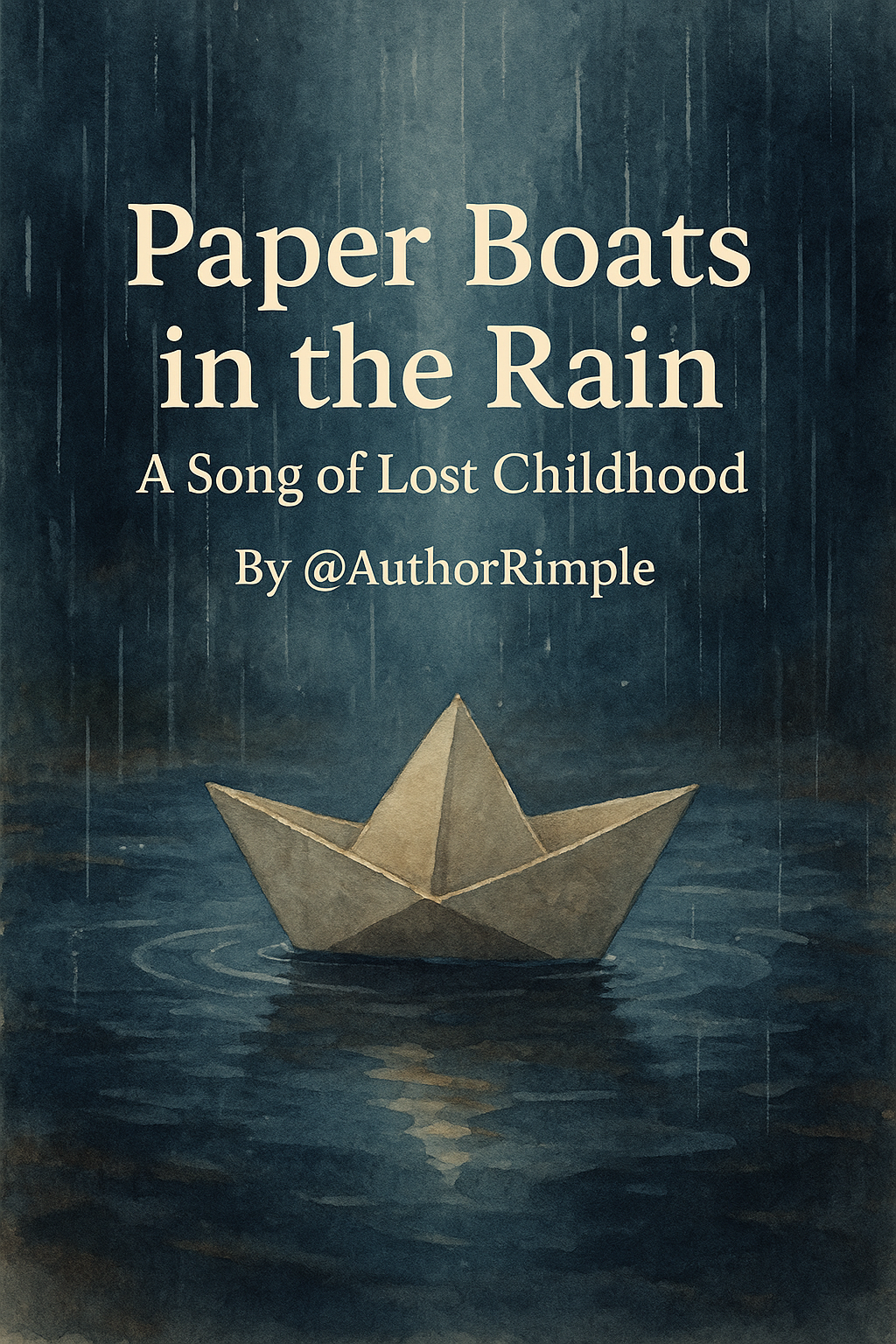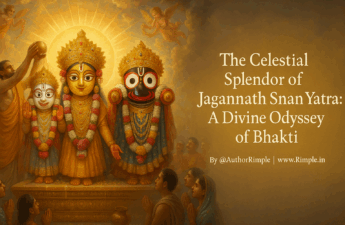Monsoons of Memory
The song Ye Daulat Bhi Le Lo, sung with soul-stirring grace by Jagjit Singh and Chitra Singh, is a timeless ghazal that weaves a tapestry of nostalgia, longing, and the irreplaceable beauty of childhood. Written by Sudarshan Faakir, its verses are a poetic lament for the lost innocence of youth, a yearning for the simplicity and joy that no wealth or fame can replace. Each verse is a delicate brushstroke, painting memories so vivid they tug at the heart, evoking a universal ache for a time when life was unburdened by the complexities of adulthood. Below, I unravel the song verse by verse, exploring its lyrical beauty, deep meaning, and the people and moments it longs for, in a simple, poetic, and flowy manner.
ये दौलत भी ले लो ये शोहरत भी ले लो
भले छीन लो मुझ से मेरी जवानी
मगर मुझ को लौटा दो बचपन का सावन
वो काग़ज़ की कश्ती वो बारिश का पानी
Translation: Take my wealth, take my fame,
Take even my youth, let it wane.
But give me back my childhood’s monsoon,
The paper boats, the rain’s gentle tune.
Beauty and Meaning:
The first verse sets the tone of the song, a poignant barter with fate. The speaker is willing to surrender everything society deems valuable—riches, recognition, even the vigor of youth—for the fleeting, priceless moments of childhood. The imagery of “बचपन का सावन” (childhood’s monsoon) evokes a season of abundance, joy, and renewal, while “काग़ज़ की कश्ती” (paper boats) and “बारिश का पानी” (rainwater) are universal symbols of innocent play. These simple acts—folding a paper boat and watching it sail in a rain-soaked puddle—carry a purity that adult achievements cannot rival. The refrain is a cry from the heart, longing for a time when happiness was effortless, untainted by ambition or loss. Jagjit and Chitra Singh’s voices, tender yet heavy with yearning, make this plea feel like a whispered prayer, resonating with anyone who has ever missed the child they once were.
मोहल्ले की सब से पुरानी निशानी
वो बुढ़िया जिसे बच्चे कहते थे नानी
वो नानी की बातों में परियों का डेरा
वो चेहरे की झुर्रियों में सदियों का फेरा
भुलाए नहीं भूल सकता है कोई
वो छोटी सी रातें वो लम्बी कहानी
Translation: The neighborhood’s oldest trace,
That old woman we called Grandma with grace.
Her tales held a world of fairies’ delight,
Her wrinkles wove centuries in the night.
No one can forget, though they try as they might,
Those short nights, those stories that stretched till light.
Beauty and Meaning: This verse is a tender ode to the grandmotherly figure, a universal symbol of love and storytelling. The “बुढ़िया” (old woman) is not just a person but a monument of the past, the “पुरानी निशानी” (oldest trace) of a neighborhood alive with memories. She is the keeper of magic, her stories of fairies (“परियों का डेरा”) transporting children to enchanted realms. The wrinkles on her face are not mere lines but a map of time, carrying “सदियों का फेरा” (the cycle of centuries), suggesting wisdom and endurance. The verse captures the intimacy of childhood nights, when time seemed endless, and a single story could stretch into eternity. The longing here is for that unconditional love, the safety of a grandmother’s lap, and the wonder of tales that made the world feel vast yet secure. The Singhs’ voices, soft and evocative, cradle these lines like a lullaby, making the listener ache for those lost evenings.
कड़ी धूप में अपने घर से निकलना
वो चिड़ियाँ वो बुलबुल वो तितली पकड़ना
वो गुड़िया की शादी में लड़ना झगड़ना
वो झूलों से गिरना वो गिर के सँभलना
वो पीतल के छल्लों के प्यारे से तोहफ़े
वो टूटी हुई चूड़ियों की निशानी
Translation: Stepping out in the scorching sun’s blaze,
Chasing sparrows, bulbuls, butterflies in a daze.
Fighting, bickering at a doll’s wedding play,
Falling from swings, then rising anyway.
Those brass rings, treasures so dear,
Those broken bangles, keepsakes we revere.
Beauty and Meaning: This verse is a vibrant collage of childhood’s carefree adventures. The act of “कड़ी धूप में अपने घर से निकलना” (stepping out in the harsh sun) reflects the fearless spontaneity of children, undeterred by discomfort. Chasing birds and butterflies symbolizes a child’s curiosity, a desire to grasp the fleeting beauty of the world. The “गुड़िया की शादी” (doll’s wedding) evokes playful rituals, where children mimic adult traditions with earnestness and occasional squabbles, a microcosm of innocence. Falling from swings and getting back up mirrors the resilience of youth, a metaphor for a time when setbacks were temporary. The “पीतल के छल्ले” (brass rings) and “टूटी हुई चूड़ियाँ” (broken bangles) are humble treasures, cherished not for their worth but for the memories they hold. The verse longs for a life unburdened by adult responsibilities, where joy was found in the smallest things. The Singhs’ rendition, with its gentle ebb and flow, feels like a breeze carrying these memories back to life.
कभी रेत के ऊँचे टीलों पे जाना
घरौंदे बनाना बना के मिटाना
वो मा’सूम चाहत की तस्वीर अपनी
वो ख़्वाबों-ख़यालों की जागीर अपनी
न दुनिया का ग़म था न रिश्तों का बंधन
बड़ी ख़ूबसूरत थी वो ज़िंदगानी
Translation: Climbing high on dunes of sand,
Building castles, then breaking them by hand.
That innocent longing, a picture so pure,
Those dreams and fancies, a kingdom secure.
No worldly sorrows, no ties that bind,
How beautiful was that life, so kind.
Beauty and Meaning: The final verse is a wistful reflection on the boundless imagination of childhood. Building and destroying sandcastles (“घरौंदे बनाना बना के मिटाना”) captures the transient yet joyful creativity of youth, where the act of creation was enough, and destruction held no regret. These acts reflect “मा’सूम चाहत” (innocent longing), a desire untainted by greed or permanence. The “ख़्वाबों-ख़यालों की जागीर” (kingdom of dreams and thoughts) is a child’s mind, a realm where anything is possible. The verse mourns a time free from “दुनिया का ग़म” (worldly sorrows) and “रिश्तों का बंधन” (the bonds of relationships), when life was a canvas of freedom and wonder. The closing line, “बड़ी ख़ूबसूरत थी वो ज़िंदगानी” (how beautiful was that life), is a quiet sigh, a recognition that no adult achievement can rival that simplicity. Jagjit and Chitra Singh’s voices, layered with melancholy and reverence, make this verse feel like a farewell to a paradise lost.
The People and Moments Longed For:
The song is a love letter to childhood itself, but it also longs for specific figures and moments that defined it:
- The Grandmother (Nani): She represents unconditional love, wisdom, and the magic of storytelling. The longing for her is a yearning for comfort, security, and the belief in a world where fairies exist.
- The Playmates and Neighborhood: The children who fought over doll weddings or chased butterflies together symbolize camaraderie and shared joy. The neighborhood is a lost community, a place where every corner held a memory.
- The Self of Childhood: Above all, the song longs for the child within—the one who found joy in paper boats, brass rings, and sandcastles, unburdened by the weight of adult life.
The Deeper Meaning:
At its core, Ye Daulat Bhi Le Lo is a meditation on what truly matters. It challenges the societal obsession with wealth and fame, suggesting that the true treasures of life are the fleeting, intangible moments of childhood. The song speaks to the universal human experience of growing up and losing touch with innocence, yet it also offers solace by immortalizing those memories in verse. It reminds us that while we cannot return to the past, we can carry its beauty in our hearts, finding joy in remembering.
The Beauty of Jagjit and Chitra Singh’s Rendition:
The ghazal’s emotional depth is amplified by Jagjit and Chitra Singh’s soulful delivery. Jagjit’s voice, rich with longing, feels like a man reminiscing under a moonlit sky, while Chitra’s softer, wistful tone adds a layer of tenderness, like a mother recalling her child’s laughter. Their interplay mirrors the song’s duality—grief for what’s lost and gratitude for what was. The minimalistic instrumentation, typical of their ghazals, lets the words and emotions shine, making each verse feel like a memory whispered directly to the listener.
In its simplicity and universality, Ye Daulat Bhi Le Lo is a gem that transcends time, inviting us to pause, remember, and cherish the child within us all.
Also Read:





